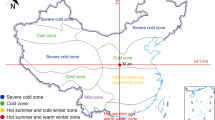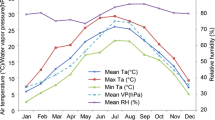Abstract
The comfort level of outdoor thermal environments is affected by several factors. Previous studies of thermal comfort have generally investigated the main microclimatic factors as dependent variables, such as the temperature, wind speed, humidity, and thermal radiation, but the influence of the air quality has rarely been explored. In this study, we acquired meteorological element observations and conducted questionnaire surveys in Peach Blossom Park, Hebei University of Technology, and Xigu Park in Tianjin. We analyzed the effects of the outdoor air quality and thermal environment on the thermal comfort in order to provide a theoretical basis for comprehensive evaluations of the outdoor environment and the mechanism. The results showed that thermal resistance of clothing and ambient temperature followed a negative step change, where people generally reduced the minimum amount of clothing when the temperature exceeded 28 °C. One unit change in the thermal sensation vote (TSV) occurred for every 11 °C rise in the physiological equivalent temperature (PET). The neutral PET was 21.68 °C, and the comfortable PET was about 23 °C. The air quality index (AQI) and air satisfaction were negatively correlated, and satisfaction decreased by 1 unit for every change of 230 AQI. The transitional season was most comfortable when the temperature felt slightly cool (TSV = −0.70). The neutral TSV was 0.507 in the summer and −0.334 in the winter. Air quality had a significant effect on the thermal comfort vote (TCV) (p = 0.0485 < 0.05). The effect of PET on TCV was highly significant (p < 0.01).
















Similar content being viewed by others
Data availability
Data derived from the current study can be provided to readers upon request.
References
Babich F, Torriani G et al (2023) Comparison of indoor air quality and thermal comfort standards and variations in exceedance for school buildings. J Build Eng 71:106405
Chen L, Ng E (2012) Outdoor thermal comfort and outdoor activities: a review of research in the past decade. Cities 29(2):118–125
Chen X, Xue P, Liu L, Gao L, Liu J (2018) Outdoor thermal comfort and adaptation in severe cold area: a longitudinal survey in Harbin, China. Build Environ 143(548-560):0360–1323. https://doi.org/10.1016/j.buildenv.2018.07.041
Cheremisinoff NP (2016) National Ambient Air Quaility Standards (NAAQS). In: In Pollution Control Handbook for Oil and Gas Engineering. John Wiley & Sons
Clausen G, Carrick L, Fanger PO, Kim SW, Poulsen T, Rindel JH (1993) A comparative study of discomfort caused by indoor air pollution, thermal load and noisec. Indoor Air 3:255–262. https://doi.org/10.1111/j.1600-0668.1993.00006.x
Fanger, P. O. Thermal comfort: analysis and applications in environmental engineering. Thermal Comfort Analysis& Applications in Environmental Engineering, 1972, 3(3): 225 – 240 Copenhagen: Danish Technical Press
Feng X (2018) Study on year-round outdoor thermal comfort based on Guangzhou area. Guangzhou University, Guangzhou
Fröhlich D, Gangwisch M, Matzarakis A (2019) Effect of radiation and wind on thermal comfort in urban environments - application of the RayMan and SkyHelios model. Urban Clim 27:1–7
Gagge AP, Fobelets AP, Berglund LG (1986) A standard predictive index of human response to the thermal environment. ASHRAE Trans 92:709–731
Hao H (2014) The influence of outdoor thermal environment factors on human thermal comfort. Central South University, Hunan
Hoppe P (1999) The physiological equivalent temperature—a universal index for the biometeorological assessment of the thermal environment. Int J Biometeorol 43(2):71–75
Hu X, Li BF, Chen H (2020) A review of outdoor thermal comfort research and assessment framework. Build Sci 36(4):53–61. https://doi.org/10.13614/j.cnki.11-1962/tu.2020.04.09
International Organization for Standardization (2002) Ergonomics of the thermal environment - instruments for measuring physical quantities (ISO 7726:1998); German version EN ISO 7726:2001:DIN EN ISO 7726. ISO
Jendritzky G et al (2012) UTCI—Why another thermal index? Int J Biometeorol 56(3):421–428
Jianlei N, Jianlin L, Lee T-C et al (2015) A new method to assess spatial variations of outdoor thermal comfort: onsite monitoring results and implications for precinct planning. Build Environ 91:263–270
Jin Y, Jin H, Kang J (2020) Combined effects of the thermal-acoustic environment on subjective evaluations in urban squares. Build Environ 168:106517.1–106517.10. https://doi.org/10.1016/j.buildenv.2019.106517
Katzschner L, Bosch U, Rottgen M (2006) Behavior of people in open spaces in dependency of thermal comfort conditions. In: 2006 - The 23rd conference on passive and low energy architecture. LEA, Geneva
Knez I, Thorsson S (2008) Thermal, emotional and perceptual evaluations of a park: cross-cultural and environmental attitude comparisons. Build Env 43(9):1483–1490
Kunming L, Yufeng Z, Lihua Z et al (2017) Applicability of thermal comfort index in urban outdoor spaces in hot and humid regions. Build Sci 33(2):15–19,166. https://doi.org/10.13614/j.cnki.11-1962/tu.2017.02.03
Lai D, Zhou C, Huang J et al (2014) Outdoor space quality: a field study in an urban residential community in central China. Energy and build 68(Jan. Pt.B):713–720
Lai D, Zhou X, Chen Q (2017) Modelling dynamic thermal sensation of human subjects in outdoor environments. Energ Build 149(8):16–25
Li K, Zhang Y, Zhao L (2016a) Outdoor thermal comfort and activities in the urban residential community in a humid subtropical area of China. Energy Build 133:498–511
Li K, Zhang Y, Zhao L (2016b) Outdoor thermal comfort and activities in the urban residential community in a humid subtropical area of China. Energy Build 133(DEC.):498–511
Li K, Zhang Y, Zhao L et al (2017) Applicability of thermal comfort index in urban outdoor spaces in hot and humid regions. Build Sci 33(2):15-19166.
Li Z, Zhang H et al (2020) Effects of frontal area density on outdoor thermal comfort and air quality. Build Environ 180:107028
Lin C, Wu L et al (2022) Characteristics of the thermal environment, air quality, and passenger comfort in the underground transfer space of metro stations in Beijing. J Build Eng 59:105093
Lin TP, Tsai KT, Hwang RL et al (2012) Quantification of the effect of thermal indices and sky view factor on park attendance. Landsc Urban Plan 107(2):137–146
Lin TP (2009a) Thermal perception, adaptation and attendance in a public square in hot and humid regions. Build Env 44(10):2017–2026
Lin T-P (2009b) Thermal perception, adaptation and attendance in a public square in hot and humid regions. Build Environ 44(10):2017–2026
Matzarakis A, Fröhlich D (2018) Influence of urban green on human thermal bioclimate – application of thermal indices and micro-scale models. Acta Hortic 1215:1–9. https://doi.org/10.17660/ActaHortic.2018.1215.1
Matzarakis A, Gangwisch M, Fröhlich D (2021) RayMan and SkyHelios Model. In: Palme M, Salvati A (eds) Urban microclimate modelling for comfort and energy studies. Springer, Cham, pp 339–361. https://doi.org/10.1007/978-3-030-65421-4_16
Matzarakis A, Rutz F, Mayer H (2007) Modelling radiation fluxes in simple and complex environments – application of the RayMan model. Int J Biometeorol 51:323–334
Matzarakis A, Rutz F, Mayer H (2010) Modelling radiation fluxes in simple and complex environments – basics of the RayMan model. Int J Biometeorol 54:131–139
Miao C, He X et al (2023) Assessing the vertical synergies between outdoor thermal comfort and air quality in an urban street canyon based on field measurements. Build Environ 227:109810
Ministry of Housing and Urban-Rural Development of the People’s Republic of China (2019) Uniform standards for the design of civil buildings: GB 50352-2019. China Construction Industry Press, Beijing, pp 7–8
Ng E, Cheng V (2012) Urban human thermal comfort in hot and humid Hong Kong. Energy Build 55(DEC.):51–65
Nikolopoulou M, Baker N, Steemers K (2001) Thermal comfort inoutdoor urban spaces: understanding the human parameter. Sol Energy 70(3):227–235
Nikolopoulou M, Lykoudis S (2006) Thermal comfort in outdoor urban spaces: analysis across different European countries. Building Env 41(11):1455–1470
Standard AS (2013) Standard 55—2013, Thermal environmental conditions for human occupancy. ASHRAE
Standing Standard Project Committee (2013) Thermal environmental condition for human occupancy: ASHRAE 55—2013. American society of heating, refrigerating and air-conditioning engineers, Inc, Atlanta
Stathopoulos T (2006) Pedestrian level winds and outdoor human comfort. J Wind Eng Ind Aerodyn 94(11):769–780
Thorsson S, Honjo T, Liudberg F et al (2007) Thermal comfort and outdoor activity in Japanese urban public places. Env Behavior 39(5):660–684
Thorsson S, Lindqvist M, Lindqvist S (2004) Thermal bioclimatic conditions and patterns of behaviour in an urban park in Göteborg, Sweden. Int J Biometeorol 48(3):149–156
Walton D, Dravitzki V, Donn M (2007) The relative influence of wind, sunlight and temperature on user comfort in urban outdoor spaces. Build Environ 42(9):3166–3175
Xi T, Lei Y, Wang S et al (2021) Study on the applicability of thermal comfort index in cold winter campus space. Build Energy Effic (in English) 49(5):126–133. https://doi.org/10.3969/j.issn.2096-9422.2021.05.024
Xi T, Lei Y (2021a) Study on the variability of thermal comfort of urban park population in winter and summer in severe cold regions. Build Sci 37(6):52–60. https://doi.org/10.13614/j.cnki.11-1962/tu.2021.06.07
Xi T, Lei Y (2021b) Study on the variability of thermal comfort of urban park population in winter and summer in severe cold regions. Build Sci 37(6):52–60. https://doi.org/10.13614/j.cnki.11-1962/tu.2021.06.07
Zhang W (2017) Research on the influence and application of regional and seasonal changes of climate on human thermal adaptation. Shaanxi:Xi'an University of Architecture and Technology. https://doi.org/10.7666/d.D01417095
Funding
The study was supported by Research on Spatial-temporal Characteristics and Inheritance Path for In-site phenotype of the Settlement Space along the Grand Canal Tianjin Section (grant number 22YJC760135) and “Belt and Road” Innovative Talent Exchange Program for foreign experts (grant number DL2022170002L).
Author information
Authors and Affiliations
Contributions
Xiangyu Gao wrote the paper. Meng Zhen modified the paper and performed the field tests. Guangmeng Bian designed the questionnaire. Qi Cheng and Zilin Chen reviewed and edited the paper. Shiyan Sha, Qi Cheng, and Tianyi Sun conducted the questionnaire survey. All authors commented on previous versions of the manuscript. All authors read and approved the final manuscript.
Corresponding author
Ethics declarations
Ethical approval and consent to participate
This research was approved by the Human Ethics Committee of School of Human Settlements and Civil Engineering, Xi’an Jiaotong University. Before conducting the questionnaire survey, the research team had informed participants that the questionnaire was anonymous and aiming at academic research.
Consent for publication
Not applicable.
Competing interests
The authors declare no competing interests.
Additional information
Responsible Editor: Philippe Garrigues
Publisher’s note
Springer Nature remains neutral with regard to jurisdictional claims in published maps and institutional affiliations.
Rights and permissions
Springer Nature or its licensor (e.g. a society or other partner) holds exclusive rights to this article under a publishing agreement with the author(s) or other rightsholder(s); author self-archiving of the accepted manuscript version of this article is solely governed by the terms of such publishing agreement and applicable law.
About this article
Cite this article
Bian, ., Gao, X., Zou, Q. et al. Effects of thermal environment and air quality on outdoor thermal comfort in urban parks of Tianjin, China. Environ Sci Pollut Res 30, 97363–97376 (2023). https://doi.org/10.1007/s11356-023-29130-3
Received:
Accepted:
Published:
Issue Date:
DOI: https://doi.org/10.1007/s11356-023-29130-3




